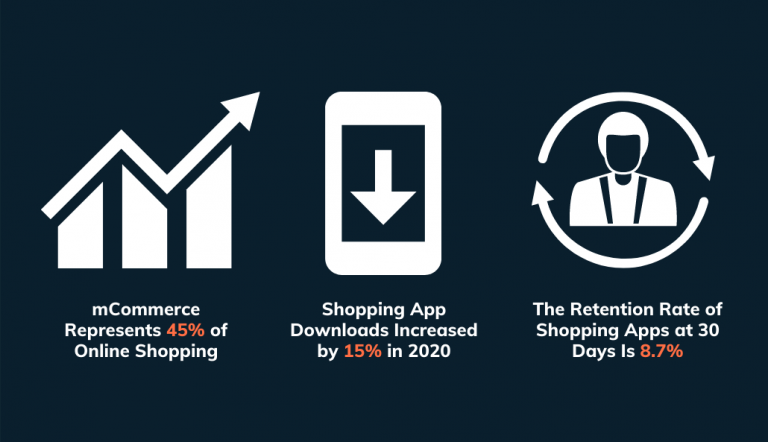The boom of mCommerce (mobile commerce) is undeniable. While buyer behavior was trending in this direction, the pandemic accelerated its market share. However, retail apps, like any other category, must strategically plan for user retention. It’s challenging, considering all the factors that influence buyer decisions. There is an opportunity to ensure shoppers stay loyal to your app and use it to complete transactions.
We’re sharing seven strategies to help you retain retail app users.
The mCommerce Landscape
First, it’s crucial to discuss the current mCommerce environment. mCommerce isn’t solely shopping within apps but relates to all transactions on mobile devices. Insider Intelligence forecasted that the channel would hit $284 billion by the end of 2020. That would represent 45% of the total U.S. eCommerce market.
The record-breaking Black Friday and Cyber Monday numbers from online shopping illustrate this increase significantly. Those numbers were across all channels, but apps played a huge role. Shopping app downloads increased by 15% year-over-year during the period.
What Are Shopping App Retention Rates?
According to Statista, the retention rate of shopping app downloads is 8.7% after 30 days (it’s 16.1% at seven days and 33.7% at one day). That may seem low, but it’s actually the number two category for retention at that point. It outperforms all others except comics. Further, we learned that during the pandemic, retail shopping app engagement increased substantially.
These points are certainly a reason for optimism based on this data point. This number could increase as the pandemic continues. That’s because it’s more likely to become a habit for users, rather than the exception.


Why are Retail Apps Attractive to Buyers?
This increase aligns with how buying behaviors are evolving. Here are four key reasons why numbers are trending up:
- In-store shopping took a hit during the pandemic, forcing non-adopters to start shopping online finally.
- Apps are creating great user experiences with less friction at checkout.
- Consumers desire convenience and easy interactions. Apps are capitalizing on these preferences with intuitive interfaces and chatbots or messenger apps.
- Brands are incorporating new technology like augmented reality into their apps, such as Ikea and Sephora.
Understanding your customer and their motivations is a good foundation for retention strategies.
Retail App User Retention Strategies
An abundance of options for mobile app marketers exists regarding retention tactics. Based on our experience and customer success stories, we’re sharing our top strategies.
Leverage Offerwalls
Offerwalls are a unique type of reward campaign, as they are non-intrusive ad units. They are versatile for mobile apps, supporting top-funnel and deep-funnel events. For retail apps, the most critical deep-funnel event is purchases. They are an excellent alternative to banner ads, which most users ignore or find annoying.
Guide Users with CPE Campaigns
CPE (cost per engagement) ads focus on post-download activities. There are lots of ways to reengage app users with CPEs. Here are some ideas:
- Prompt a user to save their payment method. Now, you’ve made checkout easier and more convenient.
- Offer an onboarding tutorial. Most consumers that download a shopping app know the basics and are probably familiar with your brand. An intuitive and warm onboarding experience, however, could boost retail engagement. It can be a quick walkthrough that highlights how shopping on the app is beneficial.
- Promote loyalty or referral programs that provide incentives for shoppers (you might add some exclusive app benefits).
To understand the event’s impact, you can track if those that completed the activity purchased more frequently or their average purchase amount increased.
Understand Cohort Analysis
A cohort is a group of like users, and you want to analyze how regular and loyal users interact. You’ll want to understand:
- What features do they use?
- When they are most active?
- What are the patterns of their usage?
Answering these questions gives you critical insight to understand why a certain group of users become regulars. You can then use this to support other tactics defined below—personalization, push notifications, optimization, and reengagement.
Insert Personalization
Personalization depends on data, and your brand has plenty of it based on user behaviors on the app. It’s time to use this to develop personalized experiences. These tactics can range in complexity.
You could use static personalization, which are elements that don’t change, like adding the user’s name. Dynamic personalization, on the other hand, varies based on behaviors. The most common example is showing shoppers their viewing history or recommending complementary products based on previous purchases.
Use Push Notifications Carefully
Push notifications are a great way to communicate with customers. However, you need to be smart about and not overwhelm the user. They should be meaningful to the shopper or be specific to an event, season, promotion, etc.
These can draw users back to the retail app to check out what’s new. These push notifications also provide a chance for exclusivity. App users may qualify for special promotions or discounts, and these communications are excellent for this channel.
Continue to Optimize the Experience
Keeping your app up to date and adding new features and functions is critical to retention. When you start new iterations of your app, base it on the data you’re collecting and what’s driving customers to purchase and stay. It’s also a good idea to keep an eye on competitors and their app’s evolution. You could improve on some of their tactics if they align with your data.
Develop Campaigns for Inactive Users
Just because a customer hasn’t uninstalled your app doesn’t mean they are engaged. Work out a plan to reengage those that fall in this category. Woo them back with push notifications or emails with promotions or updates.
A Better Way to Retain Shopping App Users
These strategies illustrate ways you can retain users. Some of these relate to your internal marketing and app design. Others involve partnering with a mobile app marketing partner. Our team of retail shopping app experts can help! Contact AdAction today to discuss performance-based mobile app retention strategies.


